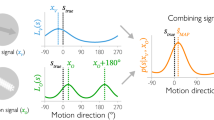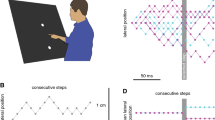Abstract
We have investigated the effect of directional uncertainty on the planning of reaching movements. For this purpose, we have used sections of annuli as spatial cues to indicate the directional range within which the target would be presented. The results showed that the reaction time of the reaching response increased with cue range and with the angle between the center of the cue and the target. In addition, the initial direction of movement was biased toward the center of the cue. These results conformed to the predictions of the capacity-sharing model. This model assumes that the processing resources used for motor planning are limited and distributed as a function of the range of directions indicated by the cue, and that when the target appears, these resources are reallocated to represent the response to be executed.


Similar content being viewed by others
References
Basso MA, Wurtz RH (1998) Modulation of neuronal activity in superior colliculus by changes of target probability. J Neurosci 15:7519–7534
Bastian A, Riehle A, Erlhagen W, Schöner G (1998) Prior information preshapes the population representation of movement direction in motor cortex. Neuroreport 9:315–319
Bock O, Arnold K (1992) Motor control prior to movement onset: preparatory mechanisms for pointing at visual targets. Exp Brain Res 90:209–216
Borowski EJ, Borwein JM (1991) The HarperCollins dictionary of mathematics. HarperCollins, New York
Castiello U, Umiltà C (1990) Size of the attentional focus and efficiency of processing. Acta Psychol 73:195–209
Dunnett CW (1955) A multiple comparison procedure for comparing several treatments with a control. J Am Statist Assoc 50:1096–1121
Eriksen CW, Yeh YY (1985) Allocation of attention in the visual field. J Exp Psychol Hum Percept Perform 11:583–597
Erlhagen W, Schöner G (2002) Dynamic field theory of movement preparation. Psychol Rev 109:545–572
Fu Q-G, Suarez JI, Ebner TJ (1993) Neuronal specification of direction and distance during reaching movements in the superior precentral premotor area and primary motor cortex of monkeys. J Neurophysiol 70:2097–2116
Georgopoulos AP, Pellizzer G (1995) The mental and the neural: psychological and neural studies of mental rotation and memory scanning. Neuropsychologia 33:1531–1547
Ghez C, Favilla M, Ghilardi MF, Gordon J, Bermejo R, Pullman S (1997) Discrete and continuous planning of hand movements and isometric force trajectories. Exp Brain Res 115:217–233
Lee D (1999) Effects of exogenous and endogenous attention on visually guided hand movements. Cogn Brain Res 8:143–156
Longstreth LE, El-Zahhar N, Alcorn MB (1985) Exceptions to Hick’s law: explorations with a response duration measure. J Exp Psychol Gen 114:417–434
Luce RD (1986) Response times. Their role in inferring elementary mental organization. Oxford Science Publications, New York
Pellizzer G (1997) Transformation of the intended direction of movement during continuous motor trajectories. Neuroreport 8:3447–3452
Pellizzer G, Hedges JH (2003) Motor planning: effect of directional uncertainty with discrete spatial cues. Exp Brain Res. DOI 10.1007/s00221-003-1453-1
Podgorny P, Shepard RN (1983) Distribution of visual attention over space. J Exp Psychol Hum Percept Perform 9:380–393
Ratcliff R (1993) Methods for dealing with reaction time outliers. Psychol Bull 114:510–532
Riehle A, Requin J (1989) Monkey primary motor and premotor cortex: single-cell activity related to prior information about direction and extent of an intended movement. J Neurophysiol 61:534–549
Riehle A, Requin J (1995) Neuronal correlates of the specification of movement direction and force in four cortical areas of the monkey. Behav Brain Res 70:1–13
Rosenbaum DA (1980) Human movement initiation: specification of arm, direction, and extent. J Exp Psychol Gen 109:444–474
Rutherford A (2001) Introducing ANOVA and ANCOVA. A GLM Approach. Sage, London
Shaw ML (1978) A capacity allocation model for reaction time. J Exp Psychol Hum Percept Perform 4:586–598
Snedecor GW, Cochran WG (1989) Statistical methods, 8th edn. Iowa State University Press, Ames, IA
Tipper SP, Howard LA, Houghton G (1998) Action-based mechanisms of attention. Philos Trans R Soc Lond B Biol Sci 353:1385–1393
Acknowledgements
This research was supported by a Merit Review Award from the Medical Research Service of the U.S. Department of Veterans Affairs. We thank Matt Chafee for his comments on a previous version of the manuscript.
Author information
Authors and Affiliations
Corresponding author
Rights and permissions
About this article
Cite this article
Pellizzer, G., Hedges, J.H. Motor planning: effect of directional uncertainty with continuous spatial cues. Exp Brain Res 154, 121–126 (2004). https://doi.org/10.1007/s00221-003-1669-0
Received:
Accepted:
Published:
Issue Date:
DOI: https://doi.org/10.1007/s00221-003-1669-0




